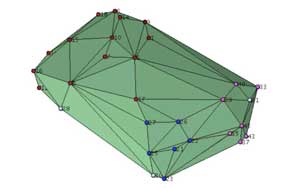
Mathematics Events at the 2007 AAAS Meeting
 |  |
Over 7000 people attended the annual meeting of the American Association for the Advancement of Science (AAAS) February 15-19. The meeting was held in San Franciso at the Hilton San Francisco & Towers, Renaissance Parc 55, and the Hotel Nikko San Francisco. Below are descriptions of some of the mathematics-related events at the meeting.
AMS Exhibit
| The Society maintained a booth in the exhibit area, which offered visitors free materials and had several AMS books on display. AMS Public Awareness Officer Annette Emerson (center) and Washington, D.C. Office staffer Anita Benjamin (left) talked to attendees and answered their questions. The 2007 calendar of Mathematical Imagery was very popular. |
New Vistas in the Mathematics of Evolution and Ecology
- "Ecological and Socioeconomic Systems as Complex Adaptive Systems," Simon Levin (Princeton University)
- "Disease and Immunity in Space and Time," Bryan Grenfell (Pennsylvania State University)
- "Climate-Driven Infectious Disease Dynamics: Understanding the Past, Forecasting the Future," Mercedes Pascual (University of Michigan)
- "Epistasis and Shapes of Fitness Landscapes," Bernd Sturmfels (University of California, Berkeley)
- "Collective Motion and Decision-Making in Animal Groups," Iain Couzin (University of Oxford)
 A projection of the subpolytope corresponding to 269 individuals whose single nucleotide polymorphisms were determined by the International HapMap project. The colors indicate four different populations: Utah-European (red), Han-Chinese (dark blue), Japanese (light blue), and Yoruba-African (pink). The underlying mathematics is presented in "Towards the Human Genotope" by Peter Huggins, Lior Pachter and Bernd Sturmfels | Levin introduced the symposium, saying that mathematics and science should do more to model large-scale phenomena. Grenfell talked about modeling measles, for which the number of cases through the years, behaves like a damped pendulum. Facts about the epidemic in the United Kingdom did not apply to the epidemic in Niger. Pascual spoke on cholera in Bangladesh and showed that much of the explanation for the number of cases was attributable to El Niño. Sturmfels used combinatorics and polytopes (graphic at left) to describe the actions of genes in HIV and in ethnic groups in the International HapMap data. What he termed the human genotope geometrically represents genetic variation in the human population. Couzin talked about his models of animal motion in fish, bees, and locusts. In the case of bees, a group will find a target even if only a small proportion of bees knows where the target is. Other bees still get to the target even though they don't know who the group experts are. |
AAAS Mentor Award for Lifetime Achievement
 Left to right: AAAS President John P. Holdren, Raymond L. Johnson, AAAS Chief Executive Officer Alan I. Leshner | Raymond L. Johnson, professor of mathematics at the University of Maryland, College Park, was honored with the AAAS Mentor Award for Lifetime Achievement for "his substantial contributions to mentoring students and for leadership in promoting Ph.D. careers among underrepresented groups in mathematical science." Johnson has mentored 23 students who have received Ph.D.'s, 22 of whom are African-American. He was the first African-American to earn a Ph.D. from Rice University. The chair of the University of Maryland Department of Mathematics says of Johnson, "the institutional success of our department in educating underrepresented minorities has been based on the leadership of Ray Johnson." |
New Mathematical Methods in the Visual Arts
- "Digital Stylometry," Dan Rockmore (Dartmouth College)
- "Digital Forensics," Hany Farid (Dartmouth College)
- "The Mathematics of Picture and Movie Restoration," Guillermo Sapiro (University of Minnesota)
- "Digital Analysis Versus the Eye of the Beholder," Ellen Handy (City College of New York)
 Dartmouth Professor Hany Farid and his students are developing software to detect doctored images, such as this fake cover of Brad Pitt and Angelina Jolie created from two different pictures of each person, when they were only rumored to have a relationship. (The tampering can be seen by looking at the shadows on their faces.) Larger image | Rockmore explained how math has been important in art for a long time -- for example, in perspective -- but now math is also used to measure style, in what is called stylometry. He gave a history of stylometry and cited recent work by Richard Taylor using fractal dimension which the Pollock-Krasner Foundation used to deny certification to a group of purported Pollocks. Rockmore also talked about work he, Siwei Lyu, and Farid did that used wavelets to distinguish a group of known Bruegel drawings from drawings like his but not attributed to him. Farid demonstrated ways to show that digital photographs have been manipulated. Some tampering can be detected by the naked eye, but more sophisticated tampering techniques can only be exposed by examining a file's coding. For example, software can detect if an object is removed from a picture and replaced by a portion of the background, by finding duplicates of the same data. Since the size and shape of the duplicated region is not known in advance, the hard part is locating the right region. Digital inpainting improves the image of a picture or movie. Sapiro's algorithms behave as art restorers do, making the surrounding region flow into the region needing repair. The flow is similar to that of water, so Sapiro uses well-established equations from fluid dynamics. Handy, an art historian, noted that attribution has traditionally been the most intuitionistic of fields, but now may become the most objective. She said that math would have to be used in more instances to judge its effectiveness: "The future is bright, but hasn't yet quite arrived." |
Prime Numbers: New Developments on Ancient Problems
- "Primes, Research, Academic Freedom, and How the National Security Agency Got What it Wanted," Susan Landau (Sun Microsystems)
- "Primal Screens," Carl Pomerance (Dartmouth College)
- "Progressions of Primes and Gaps Between Primes," Kannan Soundararajan (University of Michigan, Ann Arbor)
- "The Riemann Hypothesis," Brian Conrey (American Institute of Mathematics)
 | An overflow crowd listened to talks on recent developments in prime numbers. Landau talked about the history of public-key cryptography and the US government's attempts in the 1990s to block publication and export. She also explained the basics of the Advanced Encryption Standard. Pomerance spoke on algorithms to determine if a number is prime and algorithms for factoring. He said that the primality test discovered in India in 2002 by two undergraduates and a professor was a surprise and "cryptologists don't like surprises." Many are hoping that they won't be surprised by an "easy" factoring algorithm, since many encryption techniques depend on factoring being hard. Soundararajan's talk was on the distribution of prime numbers. He spoke about the recent results of Green and Tao (on arithmetic progressions of primes), and of Goldston, Pintz, and Yildirim (on gaps between primes). Soundararajan also gave some history, showing Gauss's hand calculations of the distribution of primes. Conrey talked about Gauss as well, and showed the relationship between the Prime Number Theorem and the Riemann Hypothesis. It has now been shown that the first 10 trillion zeros of Riemann's zeta function lie on the line Re(z) = 1/2. Conrey himself has shown that at least 2/5 of the functions zeros lie on that line. (The image at left is a page of Gauss's calculations of primes between 1,000,000 and 1,100,000, which was shown in the last two symposium talks. Courtesy of Staats- und Universitätsbibliothek Göttingen (SUB)) |
"Making Mathematics Careers More Attractive: How Can University Mathematics Departments Help?," DeWitt Sumners (Florida State University), part of the symposium Mathematics and America's Future: A Call to Action
Sumners spoke on what departments can do to increase the number of mathematicians. His recommendations were:
- Improve mathematics teacher training,
- Change the culture of mathematics departments,
- Diversify mathematics course offerings, and
- Diversity mathematics degrees.
For the last two points, Sumners especially hoped that departments will increase the amount of interdisciplinarity in their courses and degrees. He said that there is a lot of demand for mathematicians, noting that companies like Akamai and Google are "turning theorems into dollars."
"An Overview of Hurricane Science and Modeling," Joannes Westerink (University of Notre Dame), part of the symposium The Science and Modeling of Hurricanes
Westerink is part of a team that has done a lot of work modeling hurricanes and associated storm surge. He showed slides and data from the 2005 hurricanes Katrina and Rita. His team's models have a very good fit between their predictions and the data, and are now being used to design hurricane barriers and for risk analysis. Wind direction, barrier islands, and the features on land are all very important in modeling hurricane storm surge. In the future, the team hopes to include more physics in its model, to solve the relevant partial differential equations more accurately and efficiently, and to design new models for the coming generation of petascale computers.
Blockbuster Science: Math and Science Behind Movies and Entertainment
- "How We Do It at Pixar," Tony DeRose (Pixar Animation)
- "Varied Math Techniques for Varied Graphics Problems," Doug Roble (Digital Domain)
DeRose is an Academy Award winner for his work representing surfaces in animated films. He showed how math is fundamental to portryaying realistic images on the screen, both in the character itself and in the lighting or shading involved in a surface. Pixar films are completely animated so the work DeRose does is a little different from that of Roble, whose company adds digital effects to films. Roble said that he and his computer graphics colleagues "steal" ideas from mathematics all the time to make adding effects easier and faster. He gave numerous examples and showed several clips from films. Roble said that he constantly goes back to Newton, Euler, and Gauss for ideas.
The 2008 AAAS annual meeting is in Boston, February 14-18. The AAAS website has more information.
You can also read about mathematics at the 2006, 2005, 2004, 2003 and 2002 AAAS meetings.
Text and photos by AMS Public Awareness Officer Mike Breen.


